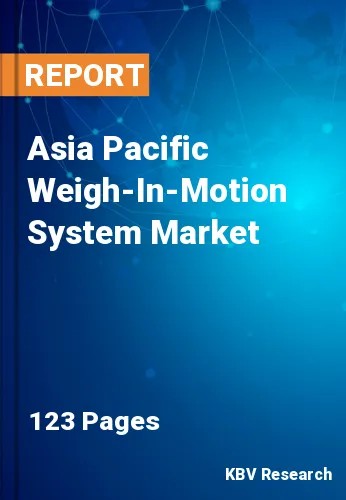The Asia Pacific Weigh-In-Motion System Market would witness market growth of 9.9% CAGR during the forecast period (2022-2028).
The accuracy of the WIM systems is affected by the environment. The most important aspect that affects all types of sensors is undoubtedly the pavement temperature. Corrections to the temperature are required as a result. The dynamic load oscillations can also lead to significant mistakes in static weight evaluation. Tire type, tire pressure, suspension characteristics (springs, dampers, hinges), speed, driving technique, road conditions, etc., all affect a vehicle's dynamic behavior.
The road pavement contains WIM sensors that are integrated into the measurement system. The fact that the road pavement lacks carefully regulated characteristics are subject to wear, and is affected by environmental factors all have a negative impact on the accuracy of the WIM sensors, making it impossible for them to have accuracy that is comparable to that of static scales.
Due to its advantages, weigh-in-motion is increasingly being used in cars, which will drive the market's growth throughout the forecast period. Onboard weigh-in-motion systems are mounted in the cars rather than being placed on the road, enabling the mass data to be supplied from a moving vehicle at any time. These platforms are used in cars. There is no need for expensive infrastructure, making them more affordable and low maintenance than other WIM frameworks.
China's ambitious One Belt, One Road initiative seeks to connect countries throughout the world by land, sea, and air routes in order to establish a single market. To integrate electric cars into its delivery network, Amazon and Mahindra Electric established a partnership in February 2021. 10,000 electric vehicles will be in Amazon's fleet by 2025. In light of this, it is anticipated that these factors would spur an increase in demand for commercial cars. The market for weigh-in-motion systems in the APAC area would also develop as a result of this.
The China market dominated the Asia Pacific Weigh-In-Motion System Market by Country in 2021; thereby, achieving a market value of $198.7 million by 2028. The Japan market is registering a CAGR of 9.2% during (2022 - 2028). Additionally, The India market would showcase a CAGR of 10.5% during (2022 - 2028).
Based on Vehicle Speed, the market is segmented into Low-speed (<15 km/h), and High-speed (>15 km/h). Based on Installation Method, the market is segmented into In-road, Bridge, and Onboard. Based on Technology, the market is segmented into Bending Plate, Load Cell, Piezoelectric Sensor, and Others. Based on End-use, the market is segmented into Highway Toll & Road Safety, Oil & Refinery, and Logistics & Others. Based on Component, the market is segmented into Hardware, and Software & Services. Based on Application, the market is segmented into Weight-based Toll Collection, Weight Enforcement, Vehicle Profiling, Traffic Data Collection, Bridge Protection, and Others. Based on countries, the market is segmented into China, Japan, India, South Korea, Singapore, Malaysia, and Rest of Asia Pacific.
Free Valuable Insights: The Worldwide Weigh-In-Motion System Market is Projected to reach USD 1.9 Billion by 2028, at a CAGR of 9.4%
The market research report covers the analysis of key stake holders of the market. Key companies profiled in the report include TE Connectivity Ltd., Mettler-Toledo International, Inc., Illinois Tools Works, Inc. (Avery Weigh-Tronix, LLC), Kapsch TrafficCom AG, Q-Free ASA, EFKON GmbH (STRABAG SE), International Road Dynamics, Inc. (WiLAN) (Quarterhill Inc.), Kistler Group (Kistler Holding AG), General Electrodynamics Corporation and Ashbee Systems Ltd.
By Vehicle Speed
By Installation Method
By Technology
By End-use
By Component
By Application
By Country
Our team of dedicated experts can provide you with attractive expansion opportunities for your business.

